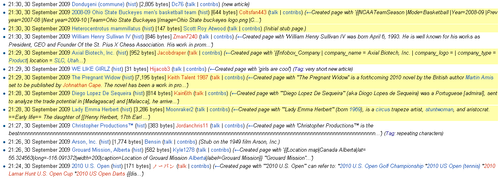Commons:Patrol
The patrol user right (patrol) is a specific user right that enables a user to mark edits, file uploads and page creations as patrolled. This is in order to reduce the backlog of new pages, new files and unpatrolled edits. It exists to tell other patrollers something has been reviewed by a patroller, that it's not vandalism (or that it has been reverted/deleted in such cases).
Users with the patrol right (Autopatrollers) will see a link like "[Mark as patrolled]" in the right bottom corner of any new page or new file, and on the right-hand side of any diff-view, that has not yet been patrolled. In addition, unpatrolled pages will be highlighted in yellow on Special:NewPages. Unpatrolled files at Special:NewFiles are not marked in any way, but can be filtered. Unpatrolled edits stand out by their ! exclamation mark in front of the line. Patrollers are supposed to check in order to see if they are not vandalism. Acceptable pages or files should be patrolled, and non-acceptable pages or files should either be rearranged or deleted if this is not possible.

How does NewPage-patrol work?[edit source]


Any pages highlighted in yellow on Special:NewPages has not yet been marked as patrolled. This means that it may not have been reviewed. When you check the page, you should mark it as patrolled if (a) you see that it is a good page or (b) before or after you tag it for deletion. If you are not sure about what to do with a page, do not mark it as patrolled; another editor will review it later.
To mark a page as patrolled, simply click the "[Mark this page as patrolled]" link in the bottom right corner of the page.
What to mark as patrolled[edit source]
- Anything that is appropriate for Commons.
- Problematic content, after it has been tagged for deletion.
What not to mark as patrolled[edit source]
- Pages you are not sure about and no one else supports keeping (other than the author/uploader).
How does edit patrol work?[edit source]
From the Recent changes click the (diff)-link of any unpatrolled edit. Then in the diff-view review the edit by clicking the "[Mark this page as patrolled]" on the righthand side. After marking the edit as patrolled you can close the page, or (in the event of vandalism or otherwise contributions not in coherence with Commons guidelines) perform an undo or rollback.
In the diff-view one can tell whether or not a talk-page exists by the color of the link. Let the user know you reverted their edit by leaving a message. See also meta:CVT.
How does file patrol work?[edit source]
File uploads can be patrolled too, from the bottom of their description. This is still a new feature for which no specific guidelines have been developed yet.
Autopatrolled users[edit source]
- Main article: Commons:Autopatrolled users
Other notes[edit source]
- A log of all patrols can be seen at Special:Log/patrol. It includes usernames, articles, and the revision reviewed, and may be sorted by username or by article title.
- Pages created and modified by administrators, bots, and users with
autopatrolright are automatically marked as "patrolled (automatic)". - There is a "Hide patrolled edits" option on Special:NewPages so that you can ignore pages that have already been reviewed.
- Even when the last few hours or even days have all been patrolled, there is still a big backlog. Pages expire from the unpatrolled queue after 720 hours (30 days).
- For those who patrol regularly there are a couple of gadgets available to assist (Popups and AjaxPatrolLinks).
CSS classes[edit source]
There are three Cascading Style Sheets classes related to patrolled edits:
- The class for non-patrolled articles in NewPages is
.not-patrolled, so colorblind users or users who prefer a different style can, for example, add.not-patrolled { border: 2px solid black }to their user CSS files. - The class for the exclamation mark is
.unpatrolled, for example.unpatrolled { display:none }hides them from the RecentChanges and your Watchlist. - The class for the "Mark this page as patrolled" link in the lower-right corner of each new page is
.patrollink, you can style it in your user CSS file, for example:.patrollink { font: bold small sans-serif}
See also[edit source]
- Commons:Rollback – a similar user right to fight vandalism
- Special:Log/patrol – a log of any patrol
- Miraheze Counter Vandalism Team – more information on countervandalism and tools to make that easier